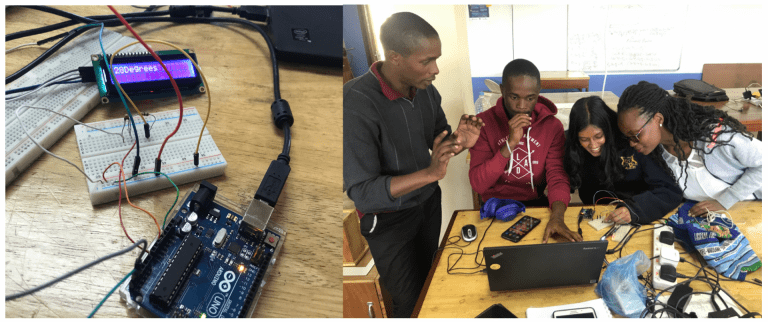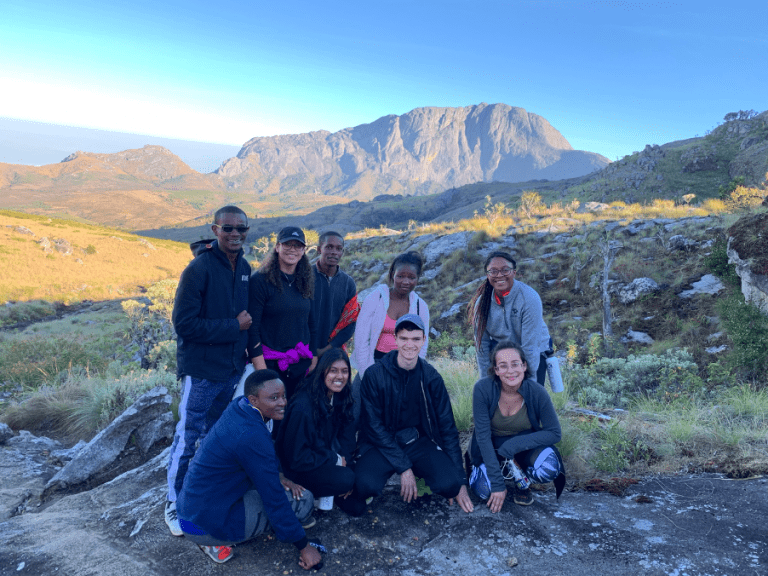Going into our 4th week of work, all 4 teams have finally begun prototyping. After 3 weeks of extensive needs-finding and research at various hospitals, we are ready to get our hands dirty. And I mean that literally. I leave the studio every day with my hands covered in a layer of solidified hot glue.
Before I get into the details about my project and the progress we made this week, I want to formally introduce my three teammates:
Joel Ngushwai: Dar es Salaam Institute of Technology
Christina Kalulu: The Malawi University – Polytechnic
Boniface Kaseka: Malawi University of Science and Technology
As I mentioned briefly in previous blogs, my team was initially tasked with developing a low-cost continuous temperature monitor for mothers during labor. The project was actually started by a team at Rice University, and now we are taking over from where they left off. The current version of the device uses a thermistor to measure temperature from the axillary artery on the upper arm. It has 3 LED’s (blue for when temperature is too low, green for when the temperature is within a safe range, and red for when the temperature is too high) and a buzzer to alert a nurse when the mother’s temperature is unsafe.

Before I delve into the details of our prototype plan, I want to talk a little about the need for continuous monitoring devices in countries like Malawi. Over eight million neonates die due to complications during pregnancy and labor per year, and 95% of these deaths take place in low resource and developing areas. Many complications that contribute to these deaths are due to changes in maternal temperature and pulse rate during labor. Intrapartum fever (≥ 38°C) and high pulse rates (≥ 100 bpm) can lead to an increased risk of complications including infections and fetal distress.
After talking to many nurses at Zomba Central Hospital, Queen Elizabeth Central Hospital, and Mulanje District Hospital, my team learned that currently, most hospitals in Malawi use non-invasive thermometers which are often lost or easily broken, and many nurses end up relying on using their hand to check whether a mother has a fever. Additionally, many wards don’t have access to pulse rate monitors, and oftentimes, nurses have to manually count the patient’s pulse rate – which means it is too time consuming to be done regularly. As a result, nurses are typically too busy or overwhelmed and don’t always end up using a partograph to record maternal vitals. In fact, a 2017 study in Malawi found that on average, 65.3% of partographs lacked temperature recordings.

These findings confirmed the need for a continuous and accurate vital signs monitoring device that can assist nurses in monitoring and recording the incidence of maternal fever and high pulse rate during labor.
With guidance from Francis Masi (who mentored the team working on this project last summer), my team has decided to make the following changes to the existing prototype:
- Include a circuit for pulse rate detection
- Transition from 4-Digit 7-Segment display to an I2C LCD or TFT LCD display
- Include a bluetooth or WiFi module to allow patient information to be stored on the device (so that nurses can access past data and view trends of temperature changes)
- Transition from a cloth armband to one that is more easily cleaned, adjustable, and comfortable
- Include battery life indicators
My team is slowly starting to formulate our project idea into a reality. This week we began recreating and troubleshooting the device’s temperature circuit using a thermistor, a basic I2C LCD Display, and 3 LEDs as a visual alert system. We also began designing the control unit (which will ultimately be 3-D printed) on SolidWorks.

It is absolutely crazy to think that we are over halfway done with our time in Malawi. In 4 and a half short weeks, I have grown to love this country and its people. I love waking up to the beautiful sunrise over the mountains that Kabula Lodge overlooks. I love cramming over 20 excited and passionate young engineering and medical students (onto a bus meant for 14 people) every morning to Queens. I love working with my team at the Poly Design Studio, eating lunch at LJ’s (a small red shack by Queens, which we have, rather appropriately, nicknamed “red shack”). I love family dinners back at Kabula with all the Rice and DIT interns. I love everything here and I’m determined to make the most of every day we have left.
***bonus content***
This weekend we finally attempted the long-overdue 3-day hike up Mount Mulanje! It was so hard that many of us found ourselves joking about how we might die before we make it to the top. Here are some pictures as proof that we made it out alive!!
— Nimisha 🙂


